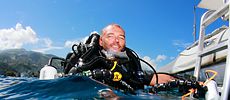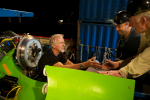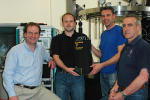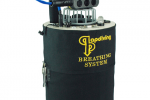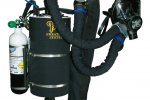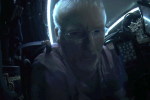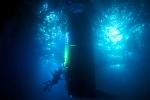Congratulations go also to our own team of designers and engineers who have played such a key role in this epic achievement.
AP Diving are very proud to have designed and manufactured the life-support system for the submarine. The APD system, responsible for keeping the pilot alive for up to 60 hours, was developed and the first units delivered within 4 months from the award of contract.
This was achieved by utilizing many standard APD rebreather components within the new design, including our patented dual controller – automatic oxygen control system – which has time-proven reliability and has been on the market for over 15 years.
The system we developed is essentially a twin rebreather, a primary and a back-up unit, each capable of 30 hours life support. The primary is open circuit (to the sub) in which CO2 is removed by blowing air through the scrubber by electric fan, powered by the sub’s own triple redundant power supply.
The independent dual oxygen controllers (primary and backup) each have their own power supply independent of each other and of the sub. Oxygen pressure within the sphere is measured and oxygen added automatically to maintain predetermined levels – just as it is in our production CCRs.
The emergency secondary system is closed circuit with breathing hoses to a full-face mask. In this system, the sub pilot uses his breath power to push the air through the scrubber filter. The closed circuit system will keep the pilot alive even if all submarine power is lost and gives the pilot a safe haven should the pilot have to deal with a fire, when smoke, carbon monoxide and fire extinguisher gases would make the cabin air un-breathable.
While the dives were being conducted we had the life support data sent to us here in Helston for analysis so we could support the team out there with advice if necessary. We have the capability to connect the life support system to a PC on board ship and interrogate the device via the internet as if it was sitting next to us; we could even re-program it if we wanted to add new features. In the event, after many successful dives, there was not much for us to do but watch with interest, but we have that capability if we need it.
Our work was designing and pre-testing so we knew it would cope with all James Cameron’s oxygen requirements and CO2 production before we delivered the system – something we were able to do in our in house ANSTI life support test system by removing all the water in the test chamber. Luckily, the internal dimensions are very similar to those in the submarine so we were able to simulate the expected conditions and test all systems across a huge range of work rates.
The Deepsea Challenge is a joint project by James Cameron, the National Geographic Society and Rolex. See the official Deepsea Challenge website for the latest news and developments as the project moves on from this historic solo dive achievement into Phase II of ongoing scientific investigation and preparation for future dives:




